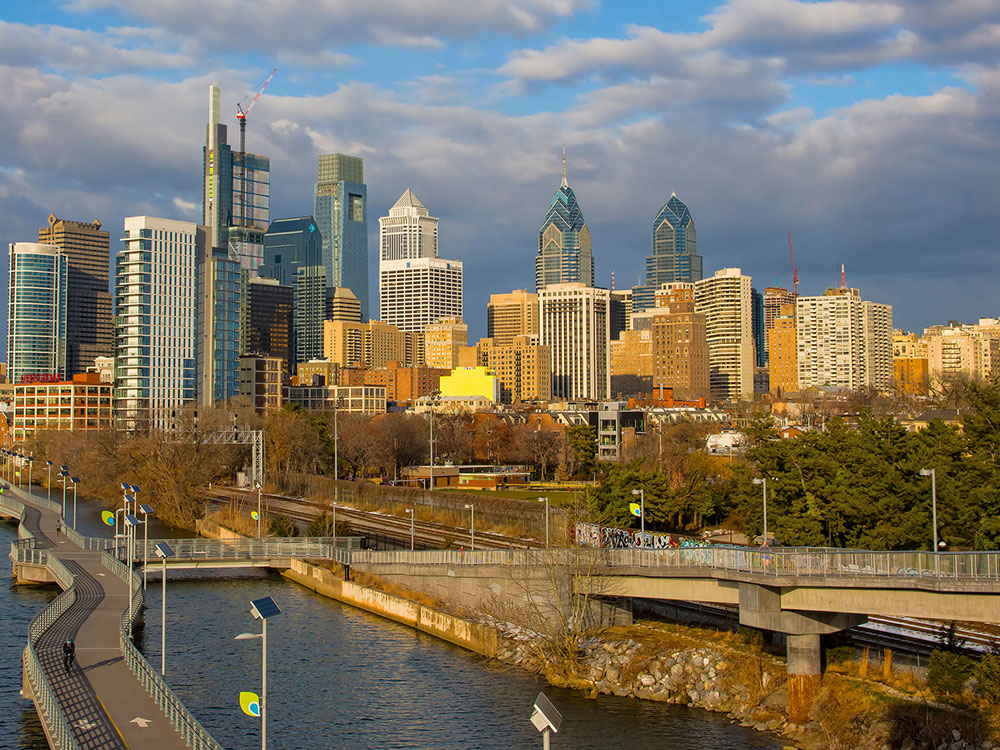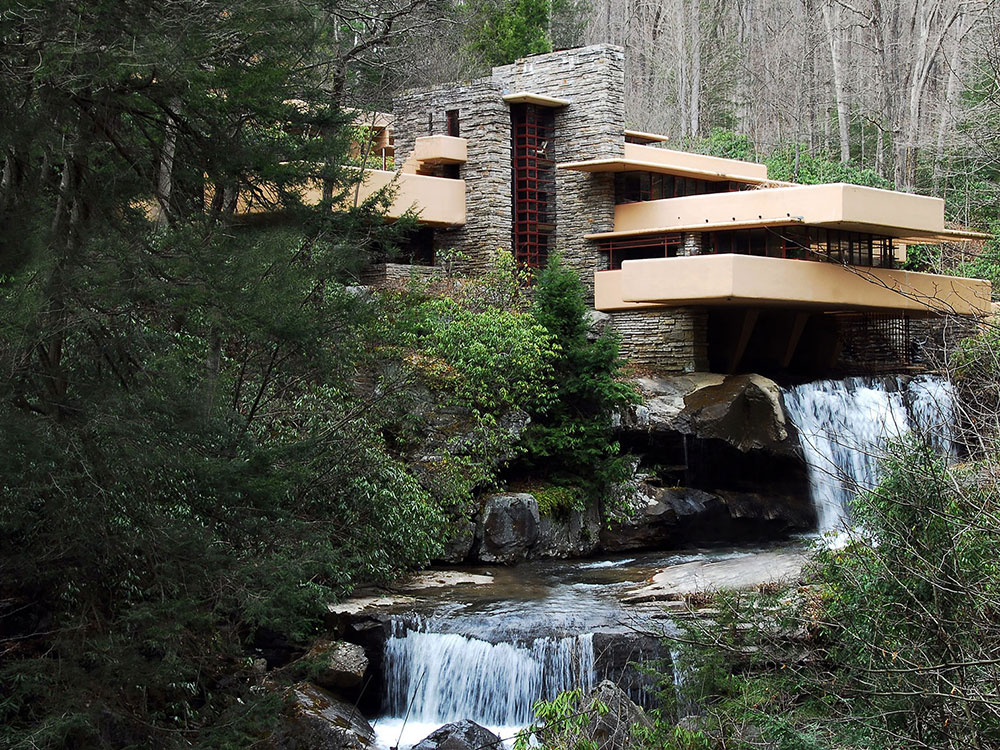Pennsylvania is a state in the Mid-Atlantic, Northeastern, and Appalachian regions of the United States. Pennsylvania's two most populous cities are Philadelphia, and Pittsburgh.
The state is one of the 13 original founding states of the United States; it came into being in 1681 as a result of a royal land grant to William Penn, the son of the state's namesake. Part of Pennsylvania (along the Delaware River), together with the present State of Delaware, had earlier been organized as the Colony of New Sweden. It was the second state to ratify the United States Constitution, on December 12, 1787. Independence Hall, where the United States Declaration of Independence and United States Constitution were drafted, is located in Philadelphia, the state's largest city. During the American Civil War, the Battle of Gettysburg was fought in the south central region of the state. Valley Forge near Philadelphia was General Washington's headquarters during the bitter winter of 1777-78.
Pennsylvania has 51 miles (82 km) of coastline along Lake Erie and 57 miles (92 km) of shoreline along the Delaware Estuary. Of the original Thirteen Colonies, Pennsylvania is the only state that does not border the Atlantic Ocean.
Cities include Philadelphia, Reading, Lebanon and Lancaster in the southeast, Pittsburgh in the southwest, the tri-cities of Allentown, Bethlehem, and Easton in the central east (known as the Lehigh Valley). The northeast includes the former anthracite coal mining cities of Scranton, Wilkes-Barre, Pittston, Nanticoke, and Hazleton. Erie is located in the northwest. State College serves the central region while Williamsport serves the commonwealth's north-central region as does Chambersburg the south-central region, with York, Carlisle, and the state capital Harrisburg on the Susquehanna River in the east-central region of the Commonwealth and Altoona and Johnstown in the west-central region.
The state has five geographical regions, namely the Allegheny Plateau, Ridge and Valley, Atlantic Coastal Plain, Piedmont, and the Erie Plain.
Historically, as of 1600, the tribes living in Pennsylvania were the Algonquian Lenape (also Delaware), the Iroquoian Susquehannock, and Petun (also Tionontati, Kentatentonga, Tobacco, Wenro.) Other tribes who entered the region during the colonial era were the Trockwae, Tutelo, Saponi, Shawnee, Nanticoke, Conoy Piscataway, Iroquois Confederacy—likely among others. Other tribes, like the Erie, may have once held land in Pennsylvania, but no longer did so by the year 1600.
Both the Dutch and the English claimed both sides of the Delaware River as part of their colonial lands in America. The Dutch were the first to take possession.
On February 28, 1681, Charles II granted a land charter to William Penn to repay a debt owed to William's father, Admiral William Penn. The King named it Pennsylvania (literally "Penn's Woods") in honor of Admiral Penn. Penn established a government with two innovations that were much copied in the New World: the county commission and freedom of religious conviction.
What had been Upland on what became the Pennsylvania side of the Pennsylvania-Delaware Border was renamed as Chester County when Pennsylvania instituted their colonial governments on March 4, 1681. The Quaker leader William Penn had signed a peace treaty with Tammany, leader of the Delaware tribe, beginning a long period of friendly relations between the Quakers and the Indians. Additional treaties between Quakers and other tribes followed.
When the Founding Fathers of the United States convened in Philadelphia in 1774, 12 colonies sent representatives to the First Continental Congress. The Second Continental Congress, which also met in Philadelphia (in May 1775), drew up and signed the Declaration of Independence in Philadelphia, but when that city was captured by the British, the Continental Congress escaped westward, meeting at the Lancaster courthouse on Saturday, September 27, 1777, and then to York. There they and its primary author, John Dickinson, drew up the Articles of Confederation that formed 13 independent States into a new union. Later, the Constitution was written, and Philadelphia was once again chosen to be cradle to the new American Union. The Constitution was drafted and signed at the Pennsylvania State House, now known as Independence Hall, and the same building where the Declaration of Independence was signed.
Pennsylvania became the first large state, and the second state to ratify the U.S. Constitution on December 12, 1787, five days after Delaware became the first. At the time it was the most ethnically and religiously diverse of the thirteen States.
Pennsylvania is home to the nation's first zoo, the Philadelphia Zoo. Other long-accredited AZA zoos include the Erie Zoo and the Pittsburgh Zoo & PPG Aquarium. The Lehigh Valley Zoo and ZOOAMERICA are other notable zoos. The Commonwealth boasts some of the finest museums in the country, including the Carnegie Museums in Pittsburgh, the Philadelphia Museum of Art, and several others. One unique museum is the Houdini Museum in Scranton, the only building in the world devoted to the legendary magician. Pennsylvania is also home to the National Aviary, located in Pittsburgh.
All 121 state parks in Pennsylvania feature free admission.
Pennsylvania is home to many major league professional sports teams: the Philadelphia Phillies and Pittsburgh Pirates of Major League Baseball, the Philadelphia 76ers of the National Basketball Association, the Pittsburgh Steelers and Philadelphia Eagles of the National Football League, the Philadelphia Flyers and Pittsburgh Penguins of the National Hockey League, and the Philadelphia Union of Major League Soccer.
Among the regional foods associated with Philadelphia are cheesesteaks, hoagie, soft pretzels, Italian water ice, Irish potato candy, scrapple, Tastykake, and strombolis. In Pittsburgh, tomato ketchup was improved by Henry John Heinz from 1876 to the early 20th century. Famous to a lesser extent than Heinz ketchup is the Pittsburgh's Primanti Brothers Restaurant sandwiches, pierogies, and city chicken. Outside of Scranton, in Old Forge there are dozens of Italian restaurants specializing in pizza made unique by thick, light crust and American cheese. Erie also has its share of unique foods, including Greek sauce and sponge candy. Sauerkraut along with pork and mashed potatoes is a common meal on New Year's Day in Pennsylvania.
Pennsylvania has been known as the Keystone State since 1802, based in part upon its central location among the original Thirteen Colonies forming the United States, and also in part because of the number of important American documents signed in the state. It was also a keystone state economically, having both the industry common to the North (making such wares as Conestoga wagons and rifles) and the agriculture common to the South (producing feed, fiber, food, and tobacco).
"The Coal State", "The Oil State", "The Chocolate State", and "The Steel State" were adopted when those were the state's greatest industries.
This article uses material from the Wikipedia article "Pennsylvania" which is released under the Creative Commons Attribution-Share-Alike License 3.0


